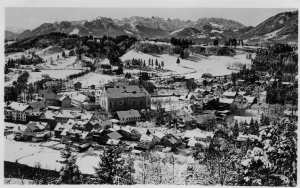
On February 24, 1941 the Division entered Federal service for one year at the call of the President. That year was extended for the duration after the sneak attack on Pearl Harbor by Japanese armed forces. In February 1942, the Division underwent a complete reorganization to a “triangular division” concept. The brigades were abolished, the artillery regiments were reduced to battalions and other reductions took place. The 102nd Infantry Regiment was detached from the Division. It became a separate regiment deploying to the Pacific.

The liner President Coolidge on which it was embarked struck two US planted mines in the harbor. The only military casualty was Captain Elwood Euart, 103nd Field Artillery, who died while rescuing some of his troops. For his bravery, Captain Euart was posthumously awarded the Distinguished Service Cross, the second highest medal for heroism authorized by the United States Army.

After a concentrated training period, the Division deployed to Guadalcanal in the Solomon Islands in February 1943. This served as the staging area for the next move to the Russell Islands, also in the Solomons. The Russells proved to be unoccupied by Japs. Further jungle and realistic combat training took place. In June and early July 1943, the Division landed on Rendova and New Georgia Islands. The objective here was to take the Munda Airfield on which the Japanese had started construction.

The Division augmented by elements of the 37th and 25th Infantry Divisions secured the airstrip in early August 1943.

In December 1943 / January 1944, the Division returned to New Zealand. After a period of rest and relaxation during which the soldiers of the 43rd became fast friends with the Kiwis, a friendship that endures to this day, the 43rd absorbed many replacements. Vigorous and intensive training took place for several months. In July 1944 the Division became part of the force driving the Japs from New Guinea. Landing at Aitape, the 43rd prevented the Japs from reinforcing their troops along the Drinimour River. This successful campaign evolved into preparation for the invasion of the Philippine Islands.

On January 9, 1945, the 43rd Infantry Division participated in the amphibious landing at Lingayen Gulf, Luzon. After several months of almost continuous combat, the Division welcomed the explosion of the Hiroshima and Nagasaki A-bombs. In September 1945, the 43rd became one of the first Divisions to occupy Japan. Their stay there was short. however, for in October 1945, the 43rd Infantry Division was deactivated at Camp Stoneman, California.

The 43rd Division is known as the “Winged Victory Division” derived from the name of its longtime combat commander, MG Leonard F. Wing. One of the many distinctions achieved by the 43rd – it was the only Division to serve in four theaters of the Pacific campaign – South Pacific, Southwest Pacific, Philippines, and Japan.
Congressional Medal of Honor: 2
Distinguished Service Cross: 71
Distinguished Service Medal: 1
Silver Star: 987
Legion of Merit: 90
Bronze Star: 2947
Purple Heart: 7610
Soldier’s Medal: 63
Air Medal: 31

In September of 1950 the Division once again answered the call of the President when North Korea invaded South Korea. After intensive training at Camp Pickett, Virginia, the 43rd deployed to Germany to join the NATO forces containing the Warsaw Pact nations in Western Europe. Training, extensive field maneuvers, and the occupation of blocking positions were the Division’s lot for almost three years. In 1953 the 43rd was redesignated the 5th Infantry Division. The Colors of the 43rd were returned to Hartford, Connecticut with appropriate ceremonies.
In 1953, a reconstituted Division took its place with the other National Guard Divisions on the Army’s rolls. in 1963, in one of the many downsizings of the Armed Forces, the Division left active National Guard service.